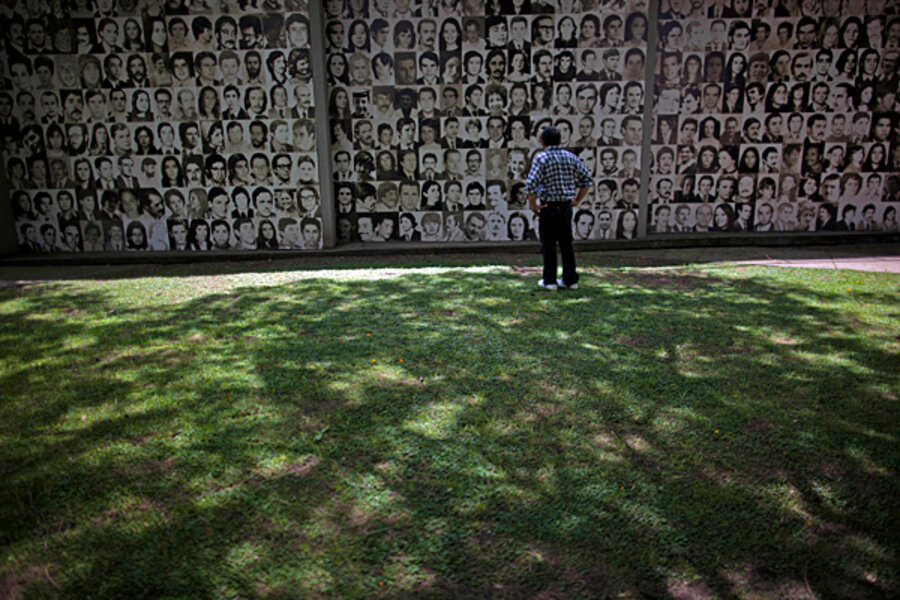Key evidence for Argentina's largest human rights case found in Florida
Loading...
| Buenos Aires
A plane discovered in 2009 in Fort Lauderdale, Florida, allegedly used by Argentina's military dictatorship to drop suspected leftists to their death into the Rio de la Plata, is now providing key evidence in the country's biggest human rights case ever.
The trial – which began last week – is the third involving the Naval Mechanics School, or ESMA, the era’s largest clandestine prison. Former officials are being charged in hundreds of instances of kidnapping, torture, and murder, and proceedings are expected to last two years, with as many as 900 witnesses testifying.
Along with the plane, crucial documents revealing the airplane’s whereabouts during Argentina’s bloody Dirty War, which took place from 1976 to 1983, were also recovered. Two other planes used by the military of the same model – a boxy Irish-built aircraft called a Skyvan – were found in Luxembourg and Great Britain.
An investigation by Argentine journalist Miriam Lewin led to the discovery of the plane, which is currently being used to transport goods from south Florida to the Bahamas, the current owner said in a report broadcast on Argentine television. It is unclear whether the owner was aware of the plane’s history prior to being interviewed by Ms. Lewin.
“[The investigation] allowed us to find not only the planes but documents that identify the pilots that participated in those flights,” Lewin said in radio comments.
The discovery also led prosecutors to request all of the flight logs still held by the Argentine coast guard, allowing them to scrutinize the planes' schedules, crew members, and reported purpose, says Alfredo Saavedra, a director at the office that tracks Argentina's human rights trials.
"[The discovery] was the jumping-off point for a wider investigation," Mr. Saavedra says, allowing prosecutors and human rights organizations like his to cross-check the plane's flight information with other testimony on where and when victims had gone missing.
‘Death flights’
The Fort Lauderdale Skyvan’s logbook included flights recorded during the dictatorship and the names of three pilots. The new evidence led to the arrest of those pilots, two of whom were employed for many years at Aerolineas Argentinas, the country’s flagship airline. And now they're on trial along with 65 former officials for crimes against 789 victims, making it the biggest case so far resulting from abuses committed under military rule in Argentina.
Prosecutors allege that the plane found in Fort Lauderdale was used in the disappearance of several of the founding members of the Madres de la Plaza de Mayo, a group of mothers searching for their children that disappeared during the dictatorship, and two French nuns, all of whom met at the Church of Santa Cruz. The bodies of these individuals washed ashore in the coastal town of Santa Teresita in the weeks after they went missing in 1977, but weren’t identified by forensics experts until 2005. (Read more about a recent win for the Grandmothers of the Plaza de Mayo)
Most of the “death flight” victims were held at ESMA. There, an unknown number of prisoners were drugged before being loaded onto a truck and taken to the nearby airfield, according to past testimonies. The recovered flight logs reveal that the planes listed the coastal base of Punta Indio as their destination – about 40 miles south of Buenos Aires – though they never arrived. The planes, instead, banked out over the turbid Rio de la Plata, which eventually leads to the Atlantic Ocean.
Once over the river, prisoners were stripped naked and pushed one by one out of the cargo door of the plane, according to Adolfo Scilingo, a pilot who confessed in 1990 and is serving a sentence of 1,084 years in a Spanish prison. In total, eight pilots are accused of involvement in “death flights.”
The Argentine coast guard acquired five Skyvan planes in 1971. Two went down in battles with the British during the 1983 Falklands-Malvinas War. The remaining three were stashed in a hangar until 1995 and then sold into private use, with one eventually ending up in Fort Lauderdale.







